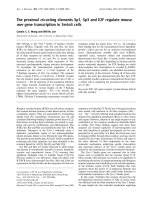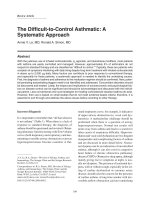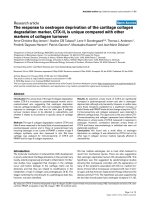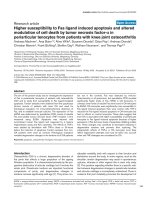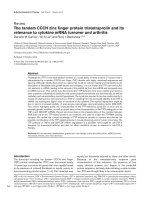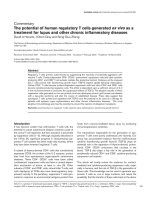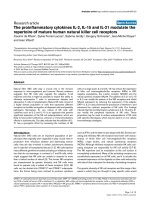Báo cáo y học: "The challenge to detect heart transplant rejection and transplant vasculopathy non-invasively a pilot study" ppsx
Bạn đang xem bản rút gọn của tài liệu. Xem và tải ngay bản đầy đủ của tài liệu tại đây (1.19 MB, 9 trang )
BioMed Central
Page 1 of 9
(page number not for citation purposes)
Journal of Cardiothoracic Surgery
Open Access
Research article
The challenge to detect heart transplant rejection and transplant
vasculopathy non-invasively a pilot study
Engin Usta*
1
, Christof Burgstahler
2
, Hermann Aebert
1
, Stephen Schroeder
2
,
Uwe Helber
2
, Andreas F Kopp
3
and Gerhard Ziemer
1
Address:
1
Department of Thoracic-, Cardiac- and Vascular Surgery, Tübingen University Hospital, Germany,
2
Department of Internal Medicine,
Division of Cardiology, Tübingen University Hospital, Germany and
3
Department of Diagnostic Radiology, Tübingen University Hospital,
Germany
Email: Engin Usta* - ; Christof Burgstahler - ;
Hermann Aebert - ; Stephen Schroeder - ;
Uwe Helber - ; Andreas F Kopp - ;
Gerhard Ziemer -
* Corresponding author
Abstract
Background: Cardiac allograft rejection and vasculopathy are the main factors limiting long-term
survival after heart transplantation.
In this pilot study we investigated whether non-invasive methods are beneficial to detect cardiac
allograft rejection (Grade 03 R) and cardiac allograft vasculopathy. Thus we compared multi-slice
computed tomography and magnetic resonance imaging with invasive methods like coronary
angiography and left endomyocardial biopsy.
Methods: 10 asymptomatic long-term survivors after heart transplantation (8 male, 2 female,
mean age 52.1 ± 12 years, 73 ± 11 months after transplantation) were included. In a blinded fashion,
coronary angiography and multi-slice computed tomography and ventricular endomyocardial
biopsy and magnetic resonance imaging were compared against each other.
Results: Cardiac allograft vasculopathy and atherosclerosis were correctly detected by multi-slice
computed tomography and coronary angiography with positive correlation (r = 1). Late contrast
enchancement found by magnetic resonance imaging correlated positively (r = 0.92, r
2
= 0.85, p <
0.05) with the histological diagnosis of transplant rejection revealed by myocardial biopsy. None of
the examined endomyocardial specimen revealed cardiac allograft rejection greater than
Grade 1 R.
Conclusion: A combined non-invasive approach using multi-slice computed tomography and
magnetic resonance imaging may help to assess cardiac allograft vasculopathy and cardiac allograft
rejection after heart transplantation before applying more invasive methods.
Published: 16 August 2009
Journal of Cardiothoracic Surgery 2009, 4:43 doi:10.1186/1749-8090-4-43
Received: 29 March 2009
Accepted: 16 August 2009
This article is available from: />© 2009 Usta et al; licensee BioMed Central Ltd.
This is an Open Access article distributed under the terms of the Creative Commons Attribution License ( />),
which permits unrestricted use, distribution, and reproduction in any medium, provided the original work is properly cited.
Journal of Cardiothoracic Surgery 2009, 4:43 />Page 2 of 9
(page number not for citation purposes)
Introduction
Since the development of heart transplantation for treat-
ment of end-stage heart failure, the early diagnosis of
transplant rejection has become essential. Regular follow-
up contributes to detection of complications like coronary
allograft vasculopathy and chronic transplant rejection
which can result in significant graft coronary artery disease
or myocardial fibrosis with loss of contractility. Coronary
allograft vasculopathy is usually clinically silent and
therefore presents a diagnostic challenge; because of con-
tinued denervation in the majority of heart transplants,
any occurrence of myocardial ischemia in those grafts is
asymptomatic with angina being rarely. They might man-
ifest sequelae of coronary artery disease, including signs of
congestive heart failure or loss of transplant function, or
they may experience arrhythmias or sudden death.
Current diagnostic standards for the diagnosis of cardiac
vasculopathy are invasive coronary angiography and for
acute or chronic transplant rejection endomyocardial
biopsy [1]. Endomyocardial biopsy is still the main tech-
nique for rejection surveillance. However biopsying is
invasive and may be associated with complications [2].
Thus, there is a need for non-invasive methods. Non-inva-
sive assessment of coronary vessels, left ventricular func-
tion and myocardial fibrosis has recently been examined
by multi-slice spiral computed tomography and magnetic
resonance imaging [3,4].
Our present pilot study was performed to analyze the rela-
tionship between the results from magnetic resonance
imaging and those from endomyocardial biopsy respec-
tively the end-points cardiac transplant rejection and its
degree of severity. Further we conducted this study to
investigate the relationship between the results from cor-
onary angiography and those from the multi-slice spiral
computed tomography respectively the end-points car-
diac transplant vasculopathy and its degree of severity.
The results should clarify if the non-invasive approach is
reliable and could be superior in long time survivors after
heart transplantation.
Methods
Routine follow-up for heart transplant patients
The routine follow-up consisted of clinical examination,
blood testing, electrocardiogram and echocardiography
and chest X-ray every three months.
Blood testing
Routine blood testing consisted of red and white blood
count with differential haemogram and cardiac enzymes
(creatinin-kinase with its isoenzyme CK-MB and Tropo-
nine I). The parameters for liver (ALT, AST, ALP, GGT,
LDH albumin and bilirubine), renal function (creatinine,
urea) and coagulation (platelet count, INR and partial
thromboplastin time) were part of the routine. Further
serum analyses were lipids (triglycerides, HDL and LDL
cholesterol), electrolytes (sodium, potassium, chloride
and magnesium) and CRP. To rule out any infectious dis-
eases virologic analyses with PCR were performed to
detect cytomegaly virus, hepatitis A-E virus, herpes sim-
plex, varicella zoster virus and human herpes virus 4.
Finally the serum levels of the immunosuppressive drugs
(cyclosporine A or mycophenolate) were analysed.
Zytological analyses
This summarizes analyses of sputum, pharyngeal smear
and urine to assess any bacterial, viral or fungal infections.
Electrocardiogram
A 12-lead electrocardiogram was part of the basic follow-
up.
Echocardiography
To assess the patient's heart valves, ejection fraction and to
rule out any vegetations and pericardial effusion patients
were examined lying on their left side on the examination
table. The images were displayed on a monitor and were
recorded. Ultrasound device and probe (S5-1, 2.5 Mhz,
iE33 Philips, Hamburg, Germany)
Chest X-ray
Chest X-ray was routinely performed to evaluate the chest
wall, lungs and heart.
Transvenous endomyocardial biopsies
Transvenous endomyocardial biopsying was performed
only as clinically indicated for systematic control or in
case of suspected rejection. The systematic controls were
performed at the following rates: at two-week intervals for
the first four months following transplantation, then at
monthly intervals until the end of the first year and finally
at two-month intervals during the second year. After this
period biopsying was performed in two year intervals.
Study population and study protocol
10 patients (8 male, 2 female, mean age 52.1 ± 12 [2964]
years, mean time after heart transplantation 72.7 ± 11
months) were included in our study (Table 1). All patients
gave informed consent before inclusion in the study. The
study was approved by the hospital ethics committee. The
study included besides one patient presenting with exer-
cise induced dyspnea only asymptomatic patients without
clinical and biochemical signs of an acute heart transplant
rejection. Patients with an acute heart transplant rejection
in the last three months were excluded. The body mass
index was 26.8 ± 1.17 [2234] kg/m
2
. 4/10 patients had an
impaired renal function with serum urea levels between
50 and 100 mg/dl and serum creatinine levels between
1.2 and 1.7 mg/dl. 5/10 patients were still carrying out
Journal of Cardiothoracic Surgery 2009, 4:43 />Page 3 of 9
(page number not for citation purposes)
their professions on a daily base of 68 hours. The basic
medication of all patients consisted of β-blockers, angi-
otensin converting enzyme inhibitors, statins, diuretics
and the antiplatelet agent acetyl salicylic acid 100 mg per
day. The immunosuppressive medication consisted in 8/
10 patients of cyclosporin A and 2/10 patients received
mycophenolate additionally. All patients were free of glu-
cocorticoids.
For the present study, which was undertaken to analyze
the relationship between the results from magnetic reso-
nance imaging and those from endomyocardial biopsy,
magnetic resonance imaging investigations were retro-
spectively selected according to the following criteria: 1) a
myocardial biopsy was obtained within one week of mag-
netic resonance imaging; 2) no intravenous treatment for
acute rejection had been given in the week preceding mag-
netic resonance imaging or in the period between mag-
netic resonance imaging and myocardial biopsy; and 3)
the patients were not identified as having a chronic trans-
plant rejection at the time of these investigations.
Further in the present study the relationship between the
results from coronary angiography and those from the
multi-slice spiral computed tomography, multi-slice spi-
ral computed tomography investigations were retrospec-
tively selected according to the following criteria: 1)
coronary angiography was performed within one week of
multi-slice spiral computed tomography; 2) no intrave-
nous treatment for acute rejection had been given in the
week preceding multi-slice spiral computed tomography
or in the period between multi-slice spiral computed tom-
ography and coronary angiography; and 3) the patients
were not identified as having a chronic transplant rejec-
tion at the time of these investigations.
Cardiologists performing the coronary angiography and
endomyocardial biopsy, radiologists performing the
multi-slice spiral computed tomography and magnetic
resonance imaging and the pathologists performing the
immunohistochemical analyses on the endomyocardial
biopsies were blinded to the results of the different exam-
inations.
Table 1: Patient characteristics and results.
Patient 1 2 3 4 5* 678* 910*
Gender M M MMMMF F M M
Age [years] 64 55 61 44 55 48 37 63 65 29
BMI 26 26 31 22 26 24 24 29 34 24
Months after HTX 89 67 70 63 79 81 90 69 62 68
Prior rejections 1 2 1000001 2
CA NL CADNLNL CS NLNLNL CS CAD
MSCT NL CADNLNL CS NLNLNL CS CAD
Calcium mass 0.06 0.13 0 0 0.81 0 0 0 11.3 NP
Biopsy 1 R1 R1 R01 R1 R01 R1 R NP
MRI DF DF DF NF NP SF NF NP DF NP
EF (%) by CA >55 <55 >55 >55 >55 >55 >55 >55 >55 >55
EF (%) by MRI 51 43 55 63 NP 60 75 NP 77 NP
EF (%) by TTE 61 48 57 71 61 61 73 62 70 69
M: male; F: female. (*) patient with cardiac pacemaker. BMI: body mass index in kg/m
2
. Calcium mass in mg CaHa. NL: no lesion. Biopsy:
classification of rejection (ISHLT). Grade 0 R: no rejection; Grade 1 R: mild rejection; Grade 2 R: moderate rejection and Grade 3 R: severe
rejection. Magnetic resonance imaging: NF: no fibrosis; SF: slight fibrosis; DF: diffuse fibrosis. NP: not performed. Coronary angiography/multi-slice
computed tomography: CAD: Coronary artery disease; CS: Coronary sclerosis. Ejection fraction EF > 55% was defined as normal.
Journal of Cardiothoracic Surgery 2009, 4:43 />Page 4 of 9
(page number not for citation purposes)
Coronary angiography
Standard (X-ray) coronary angiography was performed
according to standard procedures. Stenosis severity was
evaluated by quantitative coronary analysis (QCA,
Philips, Eindthoven, Netherlands). Coronary angiogra-
phy was performed in all patients.
Diffuse atherosclerosis was defined by wall irregularities
in coronary angiography. Lesions with a diameter stenosis
> 50% were considered to be significant and classified as
a significant stenosis or coronary artery disease.
Endomyocardial biopsying
Left ventricular endomyocardial biopsying (3 specimens
per patient) could be performed in 9/10 patients.
Endomyocardial biopsies were gained from three differ-
ent regions of the left ventricular apex with a Cordis™
biotome with a jaw volume of 5.20 mm
3
under X-ray
guidance. The obtained specimens were fixed in formalde-
hyde.
Immunohistology
The fixed biopsies were embedded in paraffin, stained
with Masson's trichrome and hematoxylin-eosin and
examined by light microscopy. For immunohistological
identification of cardiac immune cells 5 μm tissue sec-
tions were treated with avidin-biotin immunoperoxidase
(Vectastain Elite ABC Kit, Vector, Burlingame, CA, USA),
applying monoclonal antibodies: CD3 (T-cells, Novocas-
tra Laboratories, Newcastle upon Tyne, UK), PGM1, HLA-
DR (both DAKO, Hamburg, Germany). Graft rejection
was classified according to the working formulation of the
International Society for Heart and Lung Transplantation
(ISHLT) [5]. In brief, the revised (R) categories of cellular
rejection are as follows: Grade 0 R no rejection; Grade 1
R mild rejection; Grade 2 R moderate rejection and Grade
3 R severe rejection.
Multi-slice spiral computed tomography
Multi-slice spiral computed tomography was performed
by using a Sensation 16 Speed 4 D™ (Siemens Medical
Solutions, Forchheim, Germany) scanner. This technique
allows the application of dedicated spiral algorithms that
provide up to 185 ms of temporal resolution. electrocar-
diogram-gated heart phase selective imaging reconstruc-
tion was used in all patients. As all our heart transplant
patients received β-blockers, no further β-blockade prior
to the multi-slice spiral computed tomography scan was
performed. After a low dose precontrast spiral scan (colli-
mation 0.75 mm, 2.8 mm table feed/rotation, 120 kV,
133 mAs, rotation time 370 ms) with simultaneously
recorded electrocardiogram signal, a test bolus of 20 ml of
contrast medium and a chaser bolus of 20 ml of physio-
logical saline solution were injected through an 18-gauge
catheter into an antecubital vein to determine the circula-
tion time. The following scan protocol was used: 0.75 mm
collimation, caudocranial scan direction, 80 cc contrast
media (400 mg Iodine/cc) with a biphasic injection pro-
tocol (50 ml at 4 ml/s and 30 ml at 2.5 ml/s), gantry rota-
tion time 370 ms, temporal resolution 185 ms, effective
slice thickness 1.0 mm, 120 kV, approximately 650 mAs.
All scans could be performed within one single breath-
hold (1520 s). Algorithms optimized for retrospective
electrocardiogram-gated multi-slice spiral computed tom-
ography were used for reconstructing the raw data. Image
reconstruction was performed in the diastolic phase with
a relative retrospective gating between 20% and 75% of
the RR-interval. Multi-slice spiral computed tomography
radiation dose was approximately 6 mSv.
The reconstructed data of the multi-slice spiral computed
tomography were transferred to a computer workstation
for further processing (Leonardo™, Siemens Medical Solu-
tions, Forchheim, Germany)
Multi-slice spiral computed tomography image
interpretation
The scans were evaluated by two independent radiologists
blinded to clinical data coronary angiography and biopsy
results in a joint reading. Data were analysed on an offline
workstation for postprocessing (Leonardo™, Siemens,
Forchheim, Germany). Coronary calcifications were
assessed on native scans and quantified by determining
the total calcium mass expressed in mg of calcium
hydroxyapatite (CaHa). Morphological changes with
resulting narrowing of the coronary artery diameter served
as another criterion to assess coronary artery disease.
Lesions with a diameter stenosis > 50% were considered
to be significant and classified as a significant stenosis or
coronary artery disease.
Magnetic resonance imaging
Magnetic resonance imaging could only performed in 7/
10 patients includes into this study. 3 patients were
excluded due to contraindications (implanted pacemak-
ers). Total measurement time for magnetic resonance
examinations was within 45 minutes in all patients. Elec-
trocardiogram-triggered cardiac magnetic resonance
examinations were performed on a 1.5T MR scanner
(Magnetom Sonata™, Siemens Medical Solutions, Forch-
heim, Germany). Cine images (repetition time 3.08 ms,
echo time 1.54 ms, flip angle 50°, temporal resolution 46
ms), T1 weighted turbo spin echo images (repetition time
700 ms, echo time 24 ms, flip angle 180°, matrix 125 ×
256, band width 305 Hz/Pixel) and T2 weighted turbo
spin echo images (repetition time 1800 ms, echo time 84
ms, flip angle 180°, matrix 160 × 256, band width 235
Hz/Pixel), as well as delayed enhancement images using
an inversion recovery-TurboFLASH sequence (repetition
time 9.56 ms, echo time 23 ms, inversion time 200260
Journal of Cardiothoracic Surgery 2009, 4:43 />Page 5 of 9
(page number not for citation purposes)
ms, flip angle 25°, matrix 166 × 256) were acquired in the
three main cardiac axes. Cine short axis sections were
recorded from base to apex for subsequent functional
evaluation. For post contrast/delayed enhancement
images there was a delay of 15 minutes between injection
of 0.15 mmol Gadolinium-DTPA/kg body weight (Mag-
nevist™, Schering AG, Berlin, Germany) and image acqui-
sition. Inversion time was adjusted in order to minimize
signal of normal myocardium.
Magnetic resonance image interpretation
The scans were evaluated by two independent radiologists
blinded to clinical data, multi-slice computed tomogra-
phy, coronary angiography and biopsy results in a joint
reading. Electrocardiogram-triggered cardiac magnetic
resonance imaging examinations were performed on a 1.5
Tesla magnetic resonance scanner (Magnetom Sonata™,
Siemens Medical Solutions, Forchheim, Germany). Ejec-
tion fraction was calculated using short axis cine images.
T1 weighted images, T2 weighted images and late contrast
enhancement images were assessed later [6,7]. The focus
of interest was late enhancement especially in the left ven-
tricle. Location of pathologic signal enhancement was
classified as ‚local' or ‚diffuse', whereas the severity was
rated on a 3-point scale: weak, moderate, and severe signal
enhancement.
Statistics
Continuous variables are described as means and stand-
ard error of mean. We used Prism 5.0™ (GraphPad Soft-
ware Inc., San Diego, CA, USA) for the analyses.
Comparisons between discrete variables and comparisons
between proportions were made by calculating the Pear-
son product-moment correlation coefficient. For all tests,
a p value ≤ 0.05 was considered to be indicative of a sig-
nificant difference.
Results
Comparison of coronary angiography and multi-slice spiral
computed tomography
By coronary angiography and multi-slice spiral computed
tomography lesions in the epimyocardial vessel segments
could be correctly detected in all patients (Table 1). 2
patients showed diffuse atherosclerotic lesions (patient
no. 5 Calcium mass 0.81 in mg CaHa, patient no. 9 Cal-
cium mass 11.3 in mg CaHa) and coronary artery disease
was diagnosed in 2 patients (patient no. 2: stenosis of the
left main stem and left anterior descending artery (Figure
1), Calcium mass 0.13 in mg CaHa; patient no. 10: steno-
sis of the left anterior descending artery which was treated
5 days later by percutaneous coronary intervention.
Patient no. 2 was meanwhile also treated by percutaneous
coronary intervention. The complications after coronary
angiography were haematoma of the groin in 2 patients
and pericardial effusion in 2 patients, which could be
managed conservatively. After multi-slice spiral computed
tomography no complications occurred.
The results of coronary angiography and multi-slice spiral
computed tomography correlated positively with a Pear-
son coefficient r = 1.
No significant correlation could be demonstrated
between the Calcium mass and the degree of severity of
the coronary lesion (r = 0.32, r
2
= 0.1, p = 0.4).
Comparison of magnetic resonance imaging and
endomyocardial biopsy
Late contrast enhancement as a sign of myocardial injury
or scarring after prior rejections [6,7] was considered as
fibrosis and was found in 4 patients (no. 1, 2, 3 and 9).
Severely reduced left ventricular contractility was found in
patient no. 2 with coronary artery disease and two prior
acute rejections.
We found three different pattern of late contrast enhance-
ment in the left ventricle (Table 1): none in patient no. 4
(Figure 2) and 7, slight or focal late contrast enhancement
in patient no. 6 (Figure 3) and diffuse late contrast
enhancement in patient no. 1 (Figure 4), 2, 3 and 9.
The endomyocardial biopsies of patient no 4 and 7 did
not feature a rejection. In contrast to that in the endomy-
ocardial biopsies of 7 patients (patient no. 1, 2, 3, 5, 6, 8
and 9) mild transplant rejection (Grade 1 R) was evident.
In none of the patients a rejection greater than Grade 1 R
existed
A: Coronary angiogram showing the stenosis of the left main stem in patient number 2 (arrow, LAO: left anterior oblique)Figure 1
A: Coronary angiogram showing the stenosis of the
left main stem in patient number 2 (arrow, LAO: left
anterior oblique). B: Multi-slice computed tomography of
the same patient with the corresponding stenosis (arrow,
MIP: maximal intensity projection). Ao: aorta, LA: left atrium,
LM: left main artery, CX: circumflex artery.
Journal of Cardiothoracic Surgery 2009, 4:43 />Page 6 of 9
(page number not for citation purposes)
There was a significant correlation between the results of
the magnetic resonance imaging late left ventricular
enhancement sequences and the left ventricular endomy-
ocardial biopsies (p < 0.05). Furthermore, the endomyo-
cardial biopsy results respectively the histologically
determined degree of rejection correlated positively with
the late left ventricular enhancement confirming fibrosis
(r = 0.92, r
2
= 0.85, p < 0.05).
Another significant correlation existed between the results
of the magnetic resonance imaging late left ventricular
enhancement sequences and the number of prior acute
transplant rejections (r = 0.83, r
2
= 0.69, p < 0.05).
Discussion
Early detection of acute heart transplant rejection is
important, as immediate treatment contributes to a lower
incidence of rejection complications. The diagnostic gold
standard is still an endomyocardial biopsy with addi-
tional staining for CD3 and HLA-DR positive cells. Biop-
sying, however, carries considerable risks [8]. Therefore
non-invasive methods like magnetic resonance imaging
and multi-slice spiral computed tomography could be
beneficial. As a late complication after heart transplanta-
tion allograft vasculopathy should be recognized also as
early as possible to prevent a worse outcome. If consider-
ing that the diagnostic standard for the detection of trans-
plant vasculopathy is still coronary angiography with
intracoronary ultrasound the demand for a non-invasive
assessment like presented in our current study exists. In
our study we could demonstrate that by utilizing multi-
slice spiral computed tomography stenosis or arterioscle-
rotic lesions in the epimyocardial vessel segments as seen
in coronary angiography just in accordance to previous
studies [9] could be detected reliably. Future improve-
ments of the resolution capacity of multi-slice spiral com-
puted tomography could allow for assessing vasculopathy
in even much smaller vessel segments. The radiation
exposure caused by multi-slice spiral computed tomogra-
phy and coronary angiography was almost equal. During
their clinical course patients after heart transplantation
Magnetic resonance imaging of patient number 4 (short axis) featuring a homogenous pattern of the left ventricular myo-cardium (late enhancement, segmental inversion recovery TurboFLASH 2D image)Figure 2
Magnetic resonance imaging of patient number 4
(short axis) featuring a homogenous pattern of the
left ventricular myocardium (late enhancement, seg-
mental inversion recovery TurboFLASH 2D image).
RV: right ventricle. LV: left ventricle. Arrow marks right ven-
tricular late enhancement.
Magnetic resonance imaging of patient number 6 (short axis) showing a signal enhancement of the septal (arrow) and slightly of the basolateral region (arrow) of the left ventricu-lar myocardium (late enhancement, segmental inversion recovery TurboFLASH 2D image)Figure 3
Magnetic resonance imaging of patient number 6
(short axis) showing a signal enhancement of the sep-
tal (arrow) and slightly of the basolateral region
(arrow) of the left ventricular myocardium (late
enhancement, segmental inversion recovery Turbo-
FLASH 2D image). RV: right ventricle. LV: left ventricle.
Magnetic resonance imaging of patient number 1 (short axis) showing a diffuse signal enhancement (arrows) of the left ventricular myocardium (late enhancement, segmental inver-sion recovery TurboFLASH 2D image)Figure 4
Magnetic resonance imaging of patient number 1
(short axis) showing a diffuse signal enhancement
(arrows) of the left ventricular myocardium (late
enhancement, segmental inversion recovery Turbo-
FLASH 2D image). RV: right ventricle. LV: left ventricle.
Journal of Cardiothoracic Surgery 2009, 4:43 />Page 7 of 9
(page number not for citation purposes)
are exposed to a high radiation dose due to many chest X-
rays and coronary angiography. Thus additional radiation
exposure should be minimized to avoid radiation associ-
ated risk of cancer. Furthermore, for multi-slice spiral
computed tomography and coronary angiography the use
of iodinated contrast media is necessary which could add
to existing impaired renal function. In mid-term follow-
up no significant changes in renal or thyroid function
after contrast media exposure occurred at our patients.
Multi-slice computed tomography combines the advan-
tages of angiography for lumen imaging and of intravas-
cular ultrasound for coronary wall imaging, and it may
have the potential to surpass coronary angiography in the
diagnosis of coronary allograft vasculopathy [10]. Multi-
slice computed tomography as a non-invasive application
warrants its superiority over coronary angiography just
like presented in our study in the lack of any complica-
tions. In comparison to that 4 patients featured complica-
tions after coronary angiography with resulting longer
hospital stay. Like presented in our study utilizing a 16-
channel multidetector computed tomography scanner to
evaluate the utility of computed tomography for the
detection of coronary allograft vasculopathy, Romeo et al
reported a sensitivity of 83%, specificity of 95% for the
detection of coronary artery stenoses greater than 50% in
a prospective 53-patient series [11]. In comparison to
these results in our present pilot study a positive correla-
tion existed between the findings of the computed tomog-
raphy and coronary angiography. Lesions in the coronary
arteries could be ruled out or detected correctly each time.
No significant correlation could be demonstrated
between the calcium mass and the degree of severity of the
coronary lesion. One explanation could be the different
pathogenesis of coronary lesions in cardiac allograft vas-
culopathy [12].
Cardiac allograft vasculopathy
Cardiac allograft vasculopathy is a unique form of athero-
sclerosis that results from chronic immunemediated
injury to the transplanted heart, combined with multiple
nonimmunologic factors and therefore is distinct from
coronary artery disease acquired due to atherosclerosis
[12]. Coronary allograft vasculopathy causes endothelial
damage, which often results in luminal narrowing, myo-
cardial ischemia, and ultimately graft failure [13]. The
estimated risk for the development of coronary allograft
vasculopathy in heart transplant recipients is 10% per
year. The disease process in coronary allograft vasculopa-
thy differs from that in classic atherosclerosis both ana-
tomically and histologically [13,14]. Luminal narrowing
typically begins in the distal small coronary arteries and
progresses proximally to the epicardial vessels. Collateral
vessels are remarkably absent. Pathologically, there is dif-
fuse concentric atherosclerotic narrowing rather than the
focal, patchy, and often eccentric disease that typifies clas-
sic atherosclerosis, in which collateral vessels are common
[13]. For multi-slice spiral computed tomography diagno-
sis of atherosclerosis coronary calcifications were assessed
visually, and they were quantitatively determined, based
on the standard built-in algorithm using an adapted Agat-
ston-score equivalent [15]. This scoring system, however,
has a limited reproducibility [16-18]. Therefore we meas-
ured the total calcium mass expressed in mg of calcium
hydroxyapatite (CaHa). Coronary sclerosis and intimal
wall thickening with at least 50% reduction of the vessel
diameter was classified as a significant stenosis or coro-
nary artery disease. The use of calcium mass as a quantita-
tive index for the amount of calcium is more precise than
are other methods because the pixels that compose each
calcified lesion are corrected by an appropriate calibration
factor to compensate for the decreased mean computerto-
mogram numbers that result from the linear partial vol-
ume effects [19].
Coronary allograft vasculopathy is usually clinically silent
without angina due to denervation in the majority of car-
diac allografts [20]. Patients might manifest sequelae of
coronary artery disease, including signs of congestive
heart failure or loss of allograft function [21]. Early diag-
nosis of cardiac allograft vasculopathy is important
because the prevention of impending catastrophic events
is feasible in some patients through revascularization
either percutaneously with balloon angioplasty and with
or without stent implantation, or by means of bypass sur-
gery. Like presented above in our study coronary angiog-
raphy and multi-slice spiral computed tomography could
reveal a significant coronary disease interpreted as cardiac
allograft disease in two patients. Except for one of the
patients with exercise induced dsypnea no other clinical
signs existed. Both patients were treated within one week
percutaneously with balloon angioplasty and stent
implantation. Thus in our present study multi-slice spiral
computed tomography proved a useful non-invasive tool
in the assessment of transplant vasculopathy. Despite the
coincidental diagnosis of coronary sclerosis or intimal
wall thickening in two patients and coronary artery dis-
ease in further two patients we could not demonstrate a
positive correlation between the measured Calcium mass
and the detected coronary lesions. Therefore morphologi-
cal changes with resulting narrowing of the coronary
artery diameter served as another criterion to assess coro-
nary artery disease.
Cardiac allograft rejection
The ability of magnetic resonance imaging to characterize
ventricular morphology, systolic function, diastolic function,
and myocardial inflammation makes it an excellent candi-
date to noninvasively diagnose and screen for heart trans-
plant rejection unaware of its degree of severity. Normal
myocardium does not show late contrast enhancement
because Gadolinium(III)-diethyltriaminepentaacetic acid
Journal of Cardiothoracic Surgery 2009, 4:43 />Page 8 of 9
(page number not for citation purposes)
(Gd-DPTA) does not accumulate in the intracellular or inter-
stitial space. Gd-DPTA accumulation may reflect an increase
of interstitial space of inflammatory and fibrotic tissue as
well as different wash-out kinetics in those areas. Gd-DPTA
late enhancement is a tissue- or necrosisspecific staining
technique or a ligand binding to specific receptors [6,7,22].
Gadolinium is an inert extracellular contrast agent and the
amount of contrast agent in a given tissue distribution vol-
ume determines the image signal intensity the more contrast
per distribution volume the higher the signal. An important
physiological fact to remember is that the tissue volume in
normal myocardium is predominately intracellular (~75%
of the water space). Because extracellular contrast media is
excluded from this space by the intact sarcolemmal mem-
brane, the volume of distribution of a contrast medium in
normal myocardium is quite small (~25% of water space),
and one can consider viable myocytes as actively excluding
contrast media. The unifying mechanism for the hyperen-
hancement effect of nonviable myocardium may then be the
absence of viable myocytes rather than any inherent proper-
ties that are specific for acutely necrotic tissue, collagenous
scar, or other forms of nonviable tissue [23-25]. Thus there
are two possible mechanisms for a signal enhancement in
cardiac allograft rejection- fibrosis and inflammation [7]. It is
well described that cardiac allograft rejection does not show
a uniform distribution and that recurrent right ventricular
endomyocardial biopsying may result in local scars, as
existed in all of our patients included in the present study.
Therefore we gained left ventricular endomyocardial bios-
pies. In a former study histological examinations revealed no
significant difference between right and left ventricular rejec-
tion [26]. A previous study was able to disclose myocardial
fibrosis already in patients with absent or mild angiographic
cardiac allograft vasculopathy [27]. This could be a useful
diagnostic tool for the detection of earlier cardiac allograft
vasculopathy and enable an intensified medical treatment.
Limitations of this study
Our current study is a pilot study including only 10
patients with a mean time after heart transplantation of
72.7 ± 11 months. In these long-term survivors after heart
transplantation acute cardiac allograft rejections accord-
ing Grade 2 R and higher are not frequent as in the first
years after transplantation. We could only detect mild
chronic transplant rejection in our study population
equivalent to Grade 1 R (ISHLT). Patients with cardiac
pacemakers could not be evaluated by magnetic reso-
nance imaging.
Conclusion
In this pilot study multi-slice spiral computed tomogra-
phy proved to be equal to coronary angiography to detect
cardiac allograft vasculopathy in epimyocardial vessel seg-
ments in patients after heart transplantation. The results
of multi-slice spiral computed tomography and coronary
angiography showed a high positive correlation. In regard
of complications multi-slice spiral computed tomography
proved superior to coronary angiography enabling it with-
out any hospital stay underlining its cost-effectiveness.
Magnetic resonance imaging revealed left ventricular
fibrosis which seems to correlate with the histological
findings of the endomyocardial biopsy showing a mild
cardiac allograft rejection Grade 1 R according to the
ISHLT working formulation.
A combined non-invasive approach seems to be useful,
cost-effective and less harmful for the patient for detection
of cardiac allograft vasculopathy and cardiac transplant
rejection before applying invasive methods. Larger studies
should be performed to improve the sensitivity detecting
cardiac allograft rejection and possibly reduce, if not elim-
inate, the need for endomyocardial biopsy especially in
patients with acute and severe cardiac allograft rejection
with at least Grade 2 R.
Competing interests
The authors declare that they have no competing interests.
Authors' contributions
EU carried out the routine follow-up examinations,
echocardiographies and participated in the study design
and coordination. EU performed the statistical analysis.
CB, SS and UH carried out the echocardiographies, coro-
nary angiographies and endomyocardial biopsying.
Andreas F K carried out the multi-slice computed tomog-
raphy and magnetic resonance imaging and participated
in their analyses. HA and GZ conceived of the study, and
participated in its design and coordination. All authors
read and approved the final manuscript.
References
1. Komatsu S, Hirayama A, Omori Y, Ueda Y, Mizote I, Fujisawa Y, Kiy-
omoto M, Higashide T, Kodama K: Detection of Coronary Plaque
by Computed Tomography With a Novel Plaque Analysis
System, 'Plaque Map', and Comparison With Intravascular
Ultrasound and Angioscopy. Circ J 2005, 69(1):72-7.
2. Baraldi-Junkins C, Levin HR, Kasper EK, Rayburn BK, Herskowitz A,
Baughman KL: Complications of Endomyocardial Biopsy in
Heart Transplant Patients. J Heart Lung Transplant 1993, 12(1 Pt
1):63-7.
3. Shan K, Constantine G, Sivananthan M, Flamm SD: Role of Cardiac
Magnetic Resonance Imaging in the Assessment of Myocar-
dial Viability. Circulation 2004, 109(11):1328-34.
4. Goetze S, Sigurdsson G, Greenberg NL, Yamani H, Garcia MJ:
Images in Cardiovascular Medicine. Transplant Vasculopa-
thy: Evaluation With Multi-Detector Computed Tomogra-
phy. Circulation 2004, 110(9):e80-e81.
5. Stewart S, Winters GL, Fishbein MC, Tazelaar HD, Kobashigawa J,
Abrams J, Andersen CB, Angelini A, Berry GJ, Burke MM, Demetris
AJ, Hammond E, Itescu S, Marboe CC, McManus B, Reed EF, Reins-
moen NL, Rodriguez ER, Rose AG, Rose M, Suciu-Focia N, Zeevi A,
Billingham ME: Revision of the Working Formulation for the
Standardization of Nomenclature in the Diagnosis of Heart
Rejection. J Heart Lung Transplant 1990, 24(11):1710-20.
6. Johansson L, Johnsson C, Penno E, Bjornerud A, Ahlstrom H: Acute
Cardiac Transplant Rejection: Detection and Grading With
MR Imaging With a Blood Pool Contrast AgentExperimen-
tal Study in the Rat. Radiology 2002, 225(1):97-103.
Publish with BioMed Central and every
scientist can read your work free of charge
"BioMed Central will be the most significant development for
disseminating the results of biomedical research in our lifetime."
Sir Paul Nurse, Cancer Research UK
Your research papers will be:
available free of charge to the entire biomedical community
peer reviewed and published immediately upon acceptance
cited in PubMed and archived on PubMed Central
yours — you keep the copyright
Submit your manuscript here:
/>BioMedcentral
Journal of Cardiothoracic Surgery 2009, 4:43 />Page 9 of 9
(page number not for citation purposes)
7. Kim RJ, Chen EL, Lima JA, Judd RM: Myocardial Gd-DTPA Kinet-
ics Determine MRI Contrast Enhancement and Reflect the
Extent and Severity of Myocardial Injury After Acute Reper-
fused Infarction. Circulation 1996, 94(12):12-3318.
8. Baraldi-Junkins C, Levin HR, Kasper EK, Rayburn BK, Herskowitz A,
Baughman KL: Complications of Endomyocardial Biopsy in
Heart Transplant Patients. J Heart Lung Transplant 1993, 12(1 Pt
1):63-7.
9. Hoffmann U, Brady TJ, Muller J: Cardiology Patient Page. Use of
New Imaging Techniques to Screen for Coronary Artery
Disease. Circulation 2003, 108(8):e50-e53.
10. Schoepf UJ, Becker CR, Ohnesorge BM, Yucel EK: CT of Coronary
Artery Disease. Radiology 2004, 232(1):18-37.
11. Romeo G, Houyel L, Angel CY, Brenot P, Riou JY, Paul JF: Coronary
Stenosis Detection by 16-Slice Computed Tomography in
Heart Transplant Patients: Comparison With Conventional
Angiography and Impact on Clinical Management. J Am Coll
Cardiol 2005, 45(11):1826-31.
12. Billingham ME: Cardiac Transplant Atherosclerosis. Transplant
Proc 1987, 19(4 Suppl 5):19-25.
13. Aranda JM Jr, Hill J: Cardiac Transplant Vasculopathy. Chest
2000, 118(6):1792-800.
14. Salomon RN, Hughes CC, Schoen FJ, Payne DD, Pober JS, Libby P:
Human Coronary Transplantation-Associated Arterioscle-
rosis. Evidence for a Chronic Immune Reaction to Activated
Graft Endothelial Cells. Am J Pathol 1991, 138(4):791-8.
15. Agatston AS, Janowitz WR, Hildner FJ, Zusmer NR, Viamonte M Jr,
Detrano R: Quantification of Coronary Artery Calcium Using
Ultrafast Computed Tomography. J Am Coll Cardiol 1990,
15(4):827-32.
16. Wang S, Detrano RC, Secci A, Tang W, Doherty TM, Puentes G,
Wong N, Brundage BH: Detection of Coronary Calcification
With Electron-Beam Computed Tomography: Evaluation of
Interexamination Reproducibility and Comparison of Three
Image-Acquisition Protocols. Am Heart J 1996, 132(3):550-8.
17. Knollmann FD, Bocksch W, Spiegelsberger S, Hetzer R, Felix R, Hum-
mel M: Electron-Beam Computed Tomography in the Assess-
ment of Coronary Artery Disease After Heart
Transplantation. Circulation 2000, 101(17):2078-82.
18. Shemesh J, Tenenbaum A, Stroh CI, Apter S, Har-Zahav Y, Fisman EZ,
Itzchak Y, Motro M: Double-Helical CT As a New Tool for
Tracking of Allograft Atherosclerosis in Heart Transplant
Recipients. Invest Radiol 1999, 34(7):485-8.
19. Hong C, Bae KT, Pilgram TK, Suh J, Bradley D: Coronary Artery
Calcium Measurement With Multi-Detector Row CT: in
Vitro Assessment of Effect of Radiation Dose. Radiology 2002,
225(3):901-6.
20. Costanzo MR, Naftel DC, Pritzker MR, Heilman JK III, Boehmer JP,
Brozena SC, Dec GW, Ventura HO, Kirklin JK, Bourge RC, Miller
LW: Heart Transplant Coronary Artery Disease Detected by
Coronary Angiography: a Multiinstitutional Study of Preop-
erative Donor and Recipient Risk Factors. Cardiac Trans-
plant Research Database. J Heart Lung Transplant 1998,
17(8):744-53.
21. Hosenpud JD, Shipley GD, Wagner CR: Cardiac Allograft Vascu-
lopathy: Current Concepts, Recent Developments, and
Future Directions. J Heart Lung Transplant 1992, 11(1 Pt 1):9-23.
22. Wagner A, Mahrholdt H, Sechtem U, Kim RJ, Judd RM: MR Imaging
of Myocardial Perfusion and Viability. Magn Reson Imaging Clin
N Am 2003, 11(1):49-66.
23. Mahrholdt H, Wagner A, Judd RM, Sechtem U: Assessment of
Myocardial Viability by Cardiovascular Magnetic Resonance
Imaging. Eur Heart J 2002, 23(8):602-19.
24. Choudhury L, Mahrholdt H, Wagner A, Choi KM, Elliott MD, Klocke
FJ, Bonow RO, Judd RM, Kim RJ: Myocardial Scarring in Asymp-
tomatic or Mildly Symptomatic Patients With Hypertrophic
Cardiomyopathy. J Am Coll Cardiol 2002, 40(12):2156-64.
25. Weinsaft JW, Klem I, Judd RM: MRI for the Assessment of Myo-
cardial Viability. Magn Reson Imaging Clin N Am 2007, 15(4):505-vi.
26. Schuetz A, Kemkes BM, Breuer M, Brandl U, Engelhardt M, Kugler C,
Manz C, Hatz R, Gokel JM, Hammer C: Kinetics and Dynamics of
Acute Rejection After Heterotopic Heart Transplantation. J
Heart Lung Transplant 1992,
11(2 Pt 1):289-99.
27. Steen H, Merten C, Refle S, Klingenberg R, Dengler T, Giannitsis E,
Katus HA: Prevalence of Different Gadolinium Enhancement
Patterns in Patients After Heart Transplantation. J Am Coll
Cardiol 2008, 52(14):1160-7.



